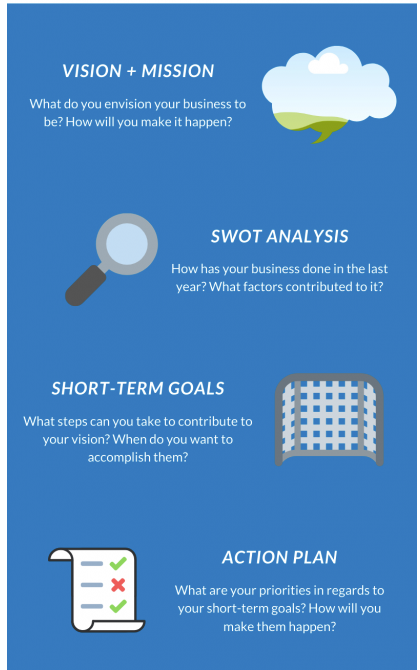Where Have You Been? – SWOT Analysis
Doing a SWOT (Strengths, Weaknesses, Opportunities, and Threats) analysis tells you how your company is doing. Think of it as your yearly check-up with your business.
Your strengths and weaknesses are about the internal processes and the opportunities and threats are about the external factors that impact your business. Some data to look for:
Strengths/Weaknesses
-
Sales numbers for the year as well as month-to-month
-
Level of sales team expertise on your inventory
-
Number of referrals from past customers
-
Revenue generated and ROI
Opportunities/Threats
-
The market you’re in
-
What business opportunities do you have?
-
What issues are you facing in attracting customers?
-
What is your competition like?
-
Short-term goals
Once you’re aware of what you’re working with, it’s time to chart out short-term goals. Think of these goals as stepping stones to your bigger goal/vision. For example, let’s say your vision is for all your customers to have the opportunity for financing. A good short-term goal would be researching lenders that work with the customer sub-sect that you’re trying to reach more and developing a shortlist of ten to contact.
Pro Tip: S.M.A.R.T. Goals
If you’ve read any books on business, you’ve probably seen the phrase S.M.A.R.T. goals somewhere. S.M.A.R.T (Specific, Measurable, Achievable, Relevant, and Time bound) goals are a way to clarify your short-term goals and make sure you’re organized for them. MindTools has a good article that dives into each word of the acronym.
Action plan
This is the exciting part. As you solidify your short-term goals, put them on a calendar and make a list of your action items. Your action items are your way of taking steps toward your short-term goals and working your vision into your day-to-day. The key here is making sure you’re actually working on that action item list. It may be tempting to put things off but remember that it’s the part of your vision that you have control of right now, so prioritize it.

You Better Watch Out
Santa Claus isn’t the only one you should watch out for. Here are some tips to be on the look out for as you’re planning: Be mindful of changes in your industry and the economy
A new year tends to bring new laws and new government regulations. Make it a point to stay informed on tax changes or process changes with your state DMV. For example, most states have been switching to electronic titling/registration systems and often they recommend certain providers, so make sure you’re working with the systems that comply with your DMV.
Don’t be afraid to adjust any part of your vision or plan, revisit them often
Things change over time and sometimes just because you put forth a vision or plan before doesn’t mean it makes sense now. As you see fit, revisit your goals and revise them. It’s important to balance a commitment to your goals with a flexible approach.
Tell your network about your goals – ask for accountability
Sharing your goals with others makes them feel more real, especially when the going gets tough. It’s all too easy to get wrapped up in the day-to-day operations of your dealership and sometimes that’s what you need to focus on. But before you forget about all the work you’ve put in already, talk to someone you’ve shared your goals with and ask them to follow up with you. The day-to-day will feel more worth it when you’re centered in something bigger.
Approaching your business with intention changes everything. Not only will your customers notice as they interact with you, but it may be a way for you to differentiate yourself from your competition.
So, the next ten years are ahead of you: make a plan and make it great!
DealerCenter has all the tools you need to make your vision for your dealership come to fruition. From our all-in-one lending and inventory management system to our powerful CRM, we can make help you turn your high hopes into high sales numbers.
* This blog post was originally published on 12/20/2019 on dealercenter.com











